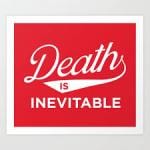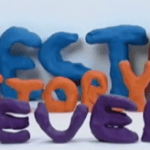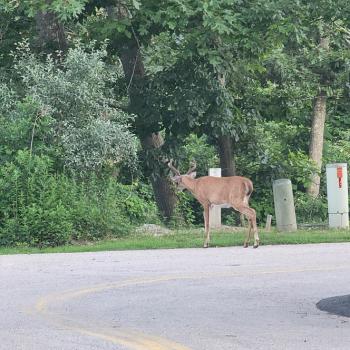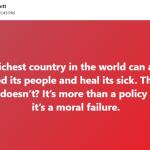There are few things that everyone can agree on these days, but here’s one: 2020 sucked. Big time. Two weeks before the end of the year, Rhode Island got hit with a Nor’easter, the most powerful and significant snowstorm to hit southern New England in a couple of years. I’m a native New Englander, and I don’t mind snow at all. I did not, however, appreciate what the storm did in the middle of the night to the gazebo that it took me two days to build last August.

That twisted, sorry-ass gazebo is, for me, a visual of 2020—last year’s final “up yours” as it wound down.
There are, however, reasons to be hopeful that 2021 will be a significantly better year than 2020. Vaccines are in the pipeline and are getting into more and more people’s arms every day. This coming semester will undoubtedly be similar to the Fall 2020 semester, with masked students in person and socially distanced in the classroom and several more on Zoom, but by September 2021 we might be getting back to “normal.” Perhaps most importantly, in three weeks a new, sane President will be inaugurated. Which causes me to remember what was happening in my life a dozen years ago.
It is twelve years since I arrived on a sub-zero January day—President Obama’s 2009 inauguration day, in fact—at the Collegeville Institute for Ecumenical and Cultural Research in Collegeville Minnesota for a semester-long sabbatical as a resident scholar. The experience changed my life; I have spent the last decade, including more than eight years on this blog, exploring and discovering the ways in which these changes have and continue to worked their way into my day-to-day reality.
One of the many friends I made while on sabbatical was a Benedictine monk named Kilian McDonnell. In the 1960s, he was the founder of the Institute where I was a resident scholar; at that time, Kilian was a young, rising theologian who, over the next three decades became somewhat of a rock star at St. John’s Abbey just up the road from the Institute, an internationally recognized and respected scholar. When I met him in early 2009, he had just turned eighty but was still full of energy and Irish wit—he looks a bit like a leprechaun and took a very strong liking to Jeanne when she visited me at Easter. I once misspelled his first name with two “l’s” in the middle—he corrected me and said “Kilian has only one “l.” Maybe when I get to heaven, they’ll let me have another one.” Another time, he told me that “Vance, sabbatical is God’s best idea, and getting old is God’s worst idea.” I have been back to the Institute and the Abbey many times in the years since my sabbatical; every time Kilian sees me at Abbey prayers, he hugs me and says “Welcome home.”
There are Kilian stories in every corner of the Institute, the Abbey, and St. John’s University where the Institute and Abbey are located; my favorite is about Kilian and the helicopter. Some years ago, Kilian arrived at evening prayer with a packed suitcase. Shortly after prayers began, the monks were interrupted by the deafening sound of a helicopter landing on the large green directly in front of the Abbey, in order to whisk Kilian off to yet another important event requiring his presence. He hopped on board and the helicopter lifted. Prayers then resumed, only to be interrupted yet again by a descending helicopter. Kilian had forgotten his suitcase; once he was united with his luggage, the helicopter lifted again, carrying him to distant parts, while evening prayer picked up at the point where it had been so rudely interrupted—twice.
Now in his nineties, in retirement and landlocked at the Abbey where he has spent more than seventy years of his life, Kilian is in the retirement wing of the monks’ residence; I last saw him when I was in Minnesota for a writers’ conference three summers ago. He’s forgetful now, but some things he doesn’t forget—after giving me a hug, the first thing he asked me was “Where’s Jeanne?” About five years before I met him, in his middle-seventies, Kilian had started writing poetry—his third volume of poetry had been published just before my arrival: “Swift, Lord, You are Not,” “Yahweh’s Other Shoe,” and “God Drops and Loses Things” (two more have been published since). Kilian’s poetry is very much like the man—to the point, often humorous, and always from an unusual angle.
I wandered through these three volumes over the past few weeks as I wrote the sermon that I gave two weeks ago at the Episcopal church I attend, looking for a poem to use for “Mary Sunday,” the last Sunday of Advent. I cornered Kilian after noon prayer one day and had him sign each of them—I had forgotten what he wrote. In one book he noted that the Abbot had commented that my daily prayers attendance put some of the monks to shame. In another, he remarked on the similarities between my life as a professor and his as a man of prayer. His inscription in the third volume particularly caught my attention.
To Vance, a man who dreams but never wastes time.
Now that’s something worth aspiring to.
I suspect that the reason Kilian’s inscription did not stick with me at the time is because I didn’t think it was true. In the manner of Hillary Clinton’s memorable, somewhat oxymoronic description of herself during the 2016 Presidential campaign as “a progressive who gets things done,” Kilian’s inscription connects two characteristics that, stereotypically at least, do not play well together. I have always been time-efficient (some might say anally-retentive) in my work life, well-organized and planning ahead. That doesn’t carry over seamlessly to my non-work life, where I can procrastinate and waste time with the best of them.
The real challenge in Kilian’s inscription, though, both then and now, is the “man who dreams” part. My father was a dreamer and a visionary of sorts, but impractical in many ways. I’ve always thought of myself as my mother’s son, introverted, practical, the person to turn a task over to once the dreamers are done dreaming about it in order to guarantee that something actually happens and the dreams come to fruition.
My administrative tasks during my academic career have invariably been executive—I was the guy asked to make the vision happen once the legislative sausage-making in the faculty senate and various committees was finished. I’ve been the person to organize and lead people, often resistant to being organized or led, as we collectively find ways to make a vision into a reality. This often requires letting the visionaries know that large parts of their dreams are impossible to do, others can only be done with significant revisions on the fly.
So, I ask myself, What did Kilian see in me that I don’t see in myself? I’ll be thinking and wondering about that as we proceed into the New Year. For starters, my New Year’s resolution is to balance task orientation with reflection, nose-to-the-grindstone with deep breaths. Dreaming certainly has something to do with hope, and hope is both a commodity without which we cannot live fully human lives, as well as a commodity that seems to be in short supply these days. My New Year’s resolution is to find reasons to be hopeful each day, then to find practical ways in which that hope can inch toward reality.













